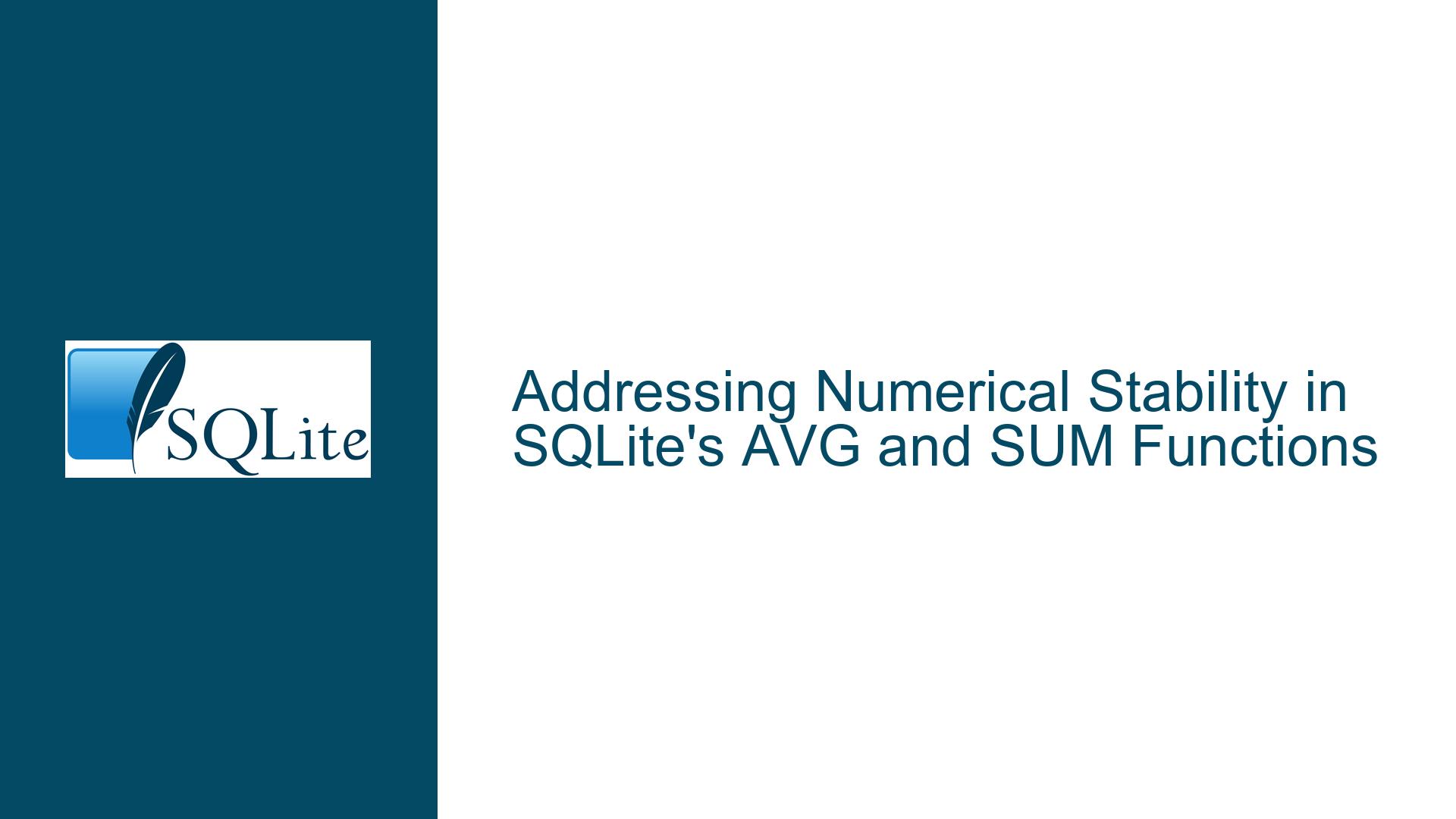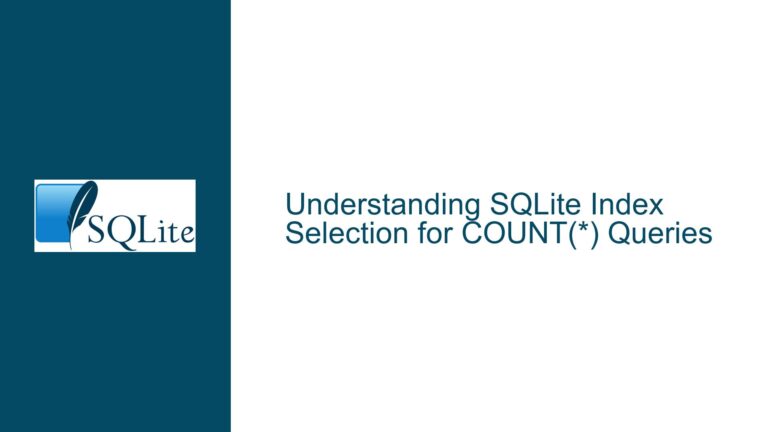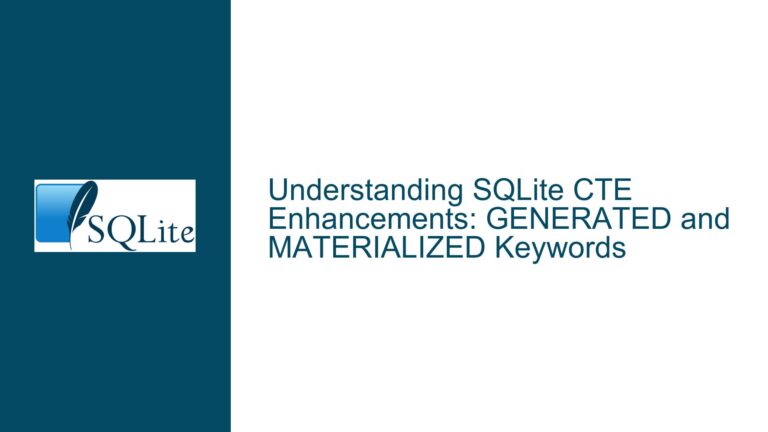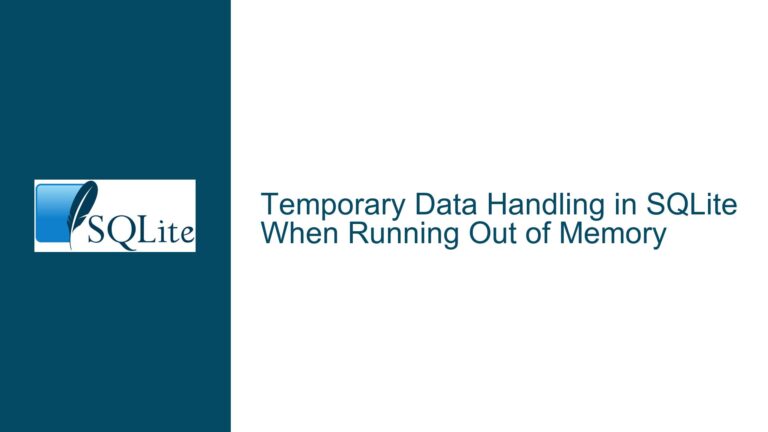Addressing Numerical Stability in SQLite’s AVG and SUM Functions
Understanding Floating-Point Precision Limitations in Aggregation Functions
Issue Overview
The core issue revolves around the numerical instability inherent in SQLite’s implementation of the AVG and SUM aggregation functions when applied to large datasets containing floating-point values. These functions rely on straightforward summation algorithms, which accumulate values sequentially. While this approach is computationally efficient, it introduces significant numerical inaccuracies under specific conditions:
Magnitude Disparity in Summation:
When summing a sequence of floating-point numbers with vastly different magnitudes, smaller values lose precision during addition. For example, adding1.0to1e100in double-precision arithmetic results in no change to the larger value due to the limited 53-bit mantissa. This "absorption" of smaller terms leads to cumulative errors.Intermediate Overflow in Averaging:
TheAVGfunction computes the mean by first summing all values and then dividing by the count. This approach risks creating an intermediate sum that far exceeds the magnitude of the final average. For instance, averaging1e20and-1e20should yield0, but if the sum is stored in a floating-point register, intermediate rounding errors during summation could produce a non-zero result.Comparison with Robust Implementations:
Systems like PostgreSQL and libraries such as Boost Accumulators employ compensated summation techniques (e.g., Kahan summation) or incremental averaging to mitigate precision loss. SQLite’s current implementation lacks these optimizations, making it susceptible to errors in scientific, financial, or statistical applications where high numerical fidelity is critical.Practical Impact:
Real-world scenarios where this becomes problematic include:- Aggregating sensor data with high dynamic range.
- Financial calculations involving large transaction volumes with small margins.
- Statistical models requiring precise mean/variance computations.
Root Causes of Numerical Instability in SQLite’s Aggregation
Possible Causes
The numerical instability arises from three interrelated factors intrinsic to floating-point arithmetic and SQLite’s aggregation logic:
Floating-Point Representation Constraints:
Double-precision floating-point numbers (IEEE 754) allocate 52 bits to the mantissa (fractional component), limiting precision to approximately 15-17 decimal digits. When the sum of values exceeds this precision, lower-order bits are truncated, introducing round-off errors. For example, summing1.0 + 1e-16yields1.0due to insufficient mantissa bits to represent the smaller term.Order-Dependent Summation:
Floating-point addition is not associative. Summing numbers from largest to smallest magnifies truncation errors, as smaller values are systematically discarded. Conversely, adding smaller values first allows them to accumulate into a magnitude comparable to larger terms. SQLite’sSUMfunction does not enforce a specific order of operations, leaving results vulnerable to input ordering.Intermediate Value Explosion in AVG:
The two-step process for computing averages—summing all values first and then dividing by the count—creates an intermediate sum that may exceed the representable range of floating-point numbers. For instance, averaging a billion values near1e30would require a sum of1e39, which exceeds the maximum representable double-precision value (~1.8e308). While this example is extreme, it illustrates the risk of overflow in large datasets.Lack of Compensated Summation:
SQLite’sSUMimplementation does not employ error-compensation techniques like Kahan summation, which track and correct for lost precision during iterative addition. This omission leads to cumulative errors proportional to the number of terms summed.
Mitigating Numerical Errors in Aggregation: Strategies and Implementation
Troubleshooting Steps, Solutions & Fixes
To address numerical instability in SQLite’s AVG and SUM, developers can adopt algorithmic improvements, schema adjustments, or hybrid approaches. Below is a detailed exploration of viable solutions:
1. Kahan Summation for Compensated Accuracy
The Kahan summation algorithm reduces truncation errors by maintaining a running compensation term that accounts for lost precision during each addition. Here’s how it works:
double sum = 0.0;
double compensation = 0.0;
for (double x : values) {
double adjusted_x = x - compensation;
double new_sum = sum + adjusted_x;
compensation = (new_sum - sum) - adjusted_x; // Captures lost precision
sum = new_sum;
}
- Advantages:
- Reduces error from O(n) to O(1) for n terms.
- Compatible with existing SQLite aggregation logic.
- Trade-offs:
- Adds computational overhead (four operations per term).
- May conflict with compiler optimizations (e.g.,
-ffast-math).
Implementation in SQLite:
Modify the sumStep function in func.c to track compensation. This would require adding a secondary accumulator variable in the aggregation context.
2. Balanced Reduction for Associative Stability
Balanced summation reorders operations to minimize magnitude disparities. By recursively splitting the dataset and summing subsets independently, this approach mimics a divide-and-conquer strategy:
double balanced_sum(double* arr, int start, int end) {
if (start == end) return arr[start];
int mid = (start + end) / 2;
return balanced_sum(arr, start, mid) + balanced_sum(arr, mid + 1, end);
}
- Advantages:
- Reduces error by grouping terms of similar magnitude.
- Parallelizable for performance.
- Trade-offs:
- Requires presorting or indexed access to data.
- Increases memory overhead for large datasets.
Integration with SQLite:
Implement a user-defined aggregate function (CREATE AGGREGATE balanced_sum ...) that sorts input values by magnitude before summation. This avoids modifying SQLite’s core but sacrifices performance.
3. Incremental Averaging for Dynamic Precision
Incremental averaging computes the mean without storing a large intermediate sum. The algorithm updates the mean iteratively:
double mean = 0.0;
int64_t n = 0;
for (double x : values) {
n++;
mean += (x - mean) / n;
}
- Advantages:
- Eliminates intermediate sum overflow.
- Numerically stable for large n.
- Trade-offs:
- Slightly higher per-iteration cost (division).
- Not directly applicable to
SUMwithout adjustments.
SQLite Custom Aggregates:
Developers can create a user-defined avg_stable function using SQLite’s C API. This approach avoids altering SQLite’s built-in AVG but requires application-level changes.
4. Extended-Precision Arithmetic
Using higher-precision types (e.g., long double or software-emulated 128-bit floats) for intermediate sums can defer precision loss. Keith Medcalf’s sqlfunc.c extension demonstrates this by redefining SUM to use LONGDOUBLE_TYPE:
#define LONGDOUBLE_TYPE __float128
typedef LONGDOUBLE_TYPE sum_accumulator;
- Advantages:
- Requires minimal algorithmic changes.
- Compatible with existing queries.
- Trade-offs:
- Platform-dependent support for extended types.
- Increased memory usage.
5. Input Presorting for Magnitude Grouping
Sorting values by absolute magnitude before summation reduces truncation errors. For example:
WITH sorted_data AS (SELECT x FROM data ORDER BY ABS(x) DESC)
SELECT SUM(x) FROM sorted_data;
- Advantages:
- Simple to implement at the query level.
- No changes to SQLite required.
- Trade-offs:
- Adds sorting overhead (O(n log n)).
- Not always practical for large or dynamic datasets.
6. Statistical Extensions for Specialized Aggregates
Keith Medcalf’s sqlfunc.c provides alternative aggregates like aavg (average of absolute values) and gavg (geometric mean), which use stabilized algorithms. Integrating these into SQLite’s core or as loadable extensions offers specialized accuracy:
-- Example using a stabilized variance function
SELECT varP(x) FROM data;
- Advantages:
- Addresses multiple statistical functions.
- Public domain licensing.
- Trade-offs:
- Increases binary size.
- Requires consensus for upstream integration.
7. Threshold-Based Hybrid Approaches
Combining multiple techniques based on dataset size or value distribution can optimize both accuracy and performance. For example:
- Use Kahan summation for small datasets (<1000 elements).
- Switch to balanced reduction for larger datasets.
- Implementation:
void sum_step(sqlite3_context* ctx, int argc, sqlite3_value** argv) { SumCtx* p = (SumCtx*)sqlite3_aggregate_context(ctx, sizeof(*p)); double x = sqlite3_value_double(argv[0]); if (p->count < 1000) { // Kahan summation } else { // Balanced reduction } p->count++; }
8. Compiler and Runtime Configuration
Disabling aggressive floating-point optimizations (e.g., -fno-fast-math in GCC) ensures that error-compensation algorithms behave as expected. This is critical for Kahan summation, which relies on precise ordering of operations.
9. User Education and Documentation
SQLite’s documentation could explicitly warn about numerical instability in aggregation functions and recommend best practices:
- Prefer
INTEGERtypes for financial calculations. - Use user-defined stabilized aggregates for sensitive applications.
- Consider scaling values (e.g., working in cents instead of dollars).
10. Community-Driven Benchmarking
Establishing quantitative benchmarks to compare summation algorithms under varying conditions (dataset size, magnitude distribution) would guide optimal implementation choices. For example:
- Measure error bounds for Kahan vs. balanced summation.
- Profile performance impact on real-world workloads.
Conclusion
Numerical instability in SQLite’s AVG and SUM stems from inherent limitations in floating-point arithmetic and the absence of error-mitigation strategies. While no single solution eliminates precision loss entirely, combining algorithmic improvements (Kahan summation, incremental averaging), schema design (scaling, presorting), and community extensions can significantly enhance accuracy. Developers must weigh trade-offs between computational overhead, implementation complexity, and numerical fidelity based on their specific use cases. Collaborative efforts to integrate stabilized aggregates into SQLite’s core or official extensions would benefit high-precision applications without compromising backward compatibility.






